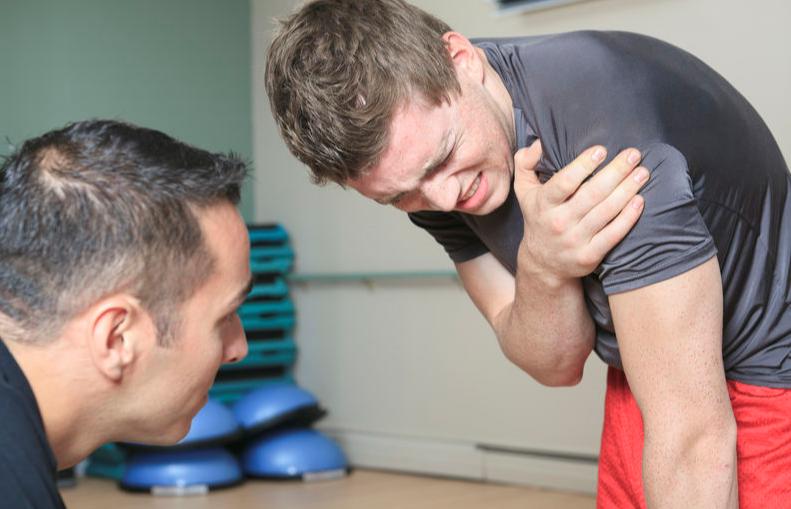Adhesive Capsulitis, or Frozen shoulder is a medical condition that results in severe pain and stiffness in the shoulder. As time progresses, this results in difficulty in movement.

Medically termed “adhesive capsulitis”, frozen shoulder detrimentally impacts the joint within the shoulder. The shoulder pain and stiffness develop into the inability to successfully move the joint.
In most instances, those suffering from this condition will find that they recover anywhere from one year to three years. There are cases when the issue does not resolve itself and intervention, such as physical therapy or surgery, is required for a complete recovery.
“I can get my arm above my head now, but still the shoulder’s killing me. I couldn’t put any pressure on it or anything. Even letting it hang is a lot of pain in the shoulder….” – Chris Mihm
Adhesive Capsulitis Causes.
The shoulder joint consists of a collection of bones, tendons, and ligaments. These are closed within an encasement of connective tissue.

When adhesive capsulitis occurs, it indicates that the encasement has started to thicken.
The unnatural thickening makes the encasement tighten up around the shoulder joint. This, in turn, restricts the movement of the joint. In order to truly understand this process, you should have a solid understanding of the basic anatomy of this area of the body:
- There are three bones that makes up the shoulder. These include the collarbone, the shoulder blade, as well as the humorous – which is the bone of the upper arm of the body.
- The joint of the shoulder is a ball and socket type. The upper arm bone has a round head and fits within the socket of the shoulder.
- Synovial fluid surrounds the shoulder joint so that it may move around freely.
- Connective tissue encases the shoulder joint and all of its components.
When frozen shoulder develops, it indicates the presence or formation of scar tissue around the shoulder joint. The underlying cause has yet to be determined. In most instances, it’s been found that an injury, excessive wear and tear, a fracture, or a disease, such as diabetes, is to blame for the onset of adhesive capsulitis.

Adhesive Capsulitis Stages.
There are three adhesive capsulitis stages and each stage consists of different symptoms.
STAGE 1
Stage 1 is referred to as “Freezing”. This is the onset of the condition. You will slowly start to experience pain. As time progresses, this pain intensifies. It will get to a point where the range of motion of the affected shoulder is limited, then, completely lost. This stage may last as little as 6 weeks or as long as 9 months. The adhesive capsulitis symptoms experienced in this stage include – but, are not at all limited to:
- Moderate to severe pain when moving the shoulder
- Increasing pain at night
- Limitations in movement of the shoulder
STAGE 2
Stage 2 is called the “Frozen” stage. For many, the pain will drop off in this stage and somewhat improve; however, it is common for the stiffness of the condition to remain. In most cases, you will remain in this stage for a period of 3 to 12 months. It is during this time that even the most basic activities that you engage in on a day-to-day basis start to become exceptionally difficult. The following highlights the most common adhesive capsulitis symptoms:
- Relief may occur, in terms of pain
- The area becomes stiff and uncomfortable
- Range of motion and movement are detrimentally impacted
STAGE 3
Stage 3 is called the “Thawing” stage. The motion and ability to move the shoulder start to improve during this stage. This stage may last as little as 6 months or as long as 2 years. You will find that it becomes easier to move. The following covers the adhesive capsulitis symptoms that may be experienced during this stage of the condition:
- The range of motion of the shoulder joint may start to revert back to normal
- Many find that the strength of the joint improves during this time
- Movements start to become easier
Adhesive Capsulitis Symptoms.
In addition to the symptoms associated with the adhesive capsulitis stages, there are many general adhesive capsulitis symptoms and situations that may occur. These include those listed below:
- Adhesive capsulitis only occurs within the shoulder joint and no other location throughout the body.
- The medical condition is classified as a “self-limited syndrome” that consists of the stages outlined previously in this guide; however, if treated, not all sufferers will go through all of the stages.
- The range of motion of the shoulder joint is limited, globally. Basically, this means that all of the motion planes of the body are negatively impacted by the general loss of motion that frozen shoulder causes.
- Generally, all individuals that suffer from frozen shoulder will completely recover; however, most find – without treatment – that there is residual restriction in and around the joint that was impacted by the condition.
- Once the condition has affected a shoulder, it is rare for it to reoccur in that shoulder; however, it is possible to experience the issue in the opposite shoulder.
- Should a medical provider order X-ray tests, the images will appear to be normal. There are some cases when the diagnostic tests are able to pick up on the presence of the condition, but this is not common.
- Many use the terms “frozen shoulder” and “arthritis” interchangeably; however, these are very different issues and are not one in the same.
- Traditionally speaking, adhesive capsulitis tends to detrimentally impact more women than men; however, both women and men are at equal risk for developing this uncomfortable medical condition.
- While adhesive capsulitis may develop at any age and to any person, it is more likely to happen at the age of 40 to the age of 65. Medical records have observed those younger that 40 that have the issue. In the same respect, frozen shoulder has been noted in those over the age of 65, too.
- In excess of 90% of all people have found that they are able to successfully overcome the pain, limited range of motion, and movement issues associated with frozen shoulder given the appropriate treatment for the condition, which is physical therapy.

Adhesive Capsulitis Risk Factors.
While the specific cause of adhesive capsulitis is generally unknown, there are several risk factors identified by medical professionals. These associated factors have made themselves known through the evaluation of the medical histories of those detrimentally affected. The following outlines those factors considered to be the most common:
- Gender – As mentioned previously, women are generally more likely than men to suffer from frozen shoulder. Medical experts feel that this could directly involve the hormonal changes that women experience in certain periods of their life, such as menopause.
- Diabetes – Individuals that are diagnosed as having diabetes are more likely to suffer from frozen shoulder. These individuals are up to 20% more likely to experience the condition. It is believed that the glucose molecules within the body of the diabetic are more likely to attach themselves to the collagen-based proteins that are located in the shoulder joint area. In turn, this results in stiffness and discomfort.
- Medical Conditions and Diseases – Those that have pre-existing medical conditions and/or diseases are more likely to develop adhesive capsulitis. Examples of these issues include complications with the thyroid, cardiovascular problems, lung issues, breast cancer, inflammatory conditions, Parkinson’s disease, and similar issues.
- Inactivity – Individuals that are inactive – for one reason or another – may develop frozen shoulder. In many cases, this inactivity stems from being sick, injured, or having surgery. Inactivity is known to increase the inflammatory response in the body. When inflammation increase, the encasement of the shoulder joint may become thick and swollen. This, in turn, detrimentally impacts the motion and comfort of the shoulder joint.
- Shoulder Issues – Those that suffer or have suffered from previous issues of the shoulder may develop adhesive capsulitis. Examples of these issues include the presence of calcium deposits on the rotator cuff of the shoulder, injury to the tendon in the shoulder, and/or any of the muscles present in the area.
- Previous Shoulder Work – If a person has had shoulder surgery performed or have had fractures or instability treated are more likely to suffer from frozen shoulder.
- Previous Issue with Frozen Shoulder – While most that have frozen shoulder do not experience the issue again, there are those that stand up to a 17% chance that the issue will develop in the opposite shoulder within a period of 5 years from the initial issue.
- Age – Those that are over 40 years of age are at a higher risk for developing adhesive capsulitis.
Activity Limitations.
Based on evaluations, self-report questionnaires, and what physical therapists have observed in their treatment of frozen shoulder, the activity limitations of this condition include the following:
- Most patients find that the condition results in pain and varying degrees of difficulty in dressing and grooming.
- Many state that they suffer from pain while attempting to sleep.
- Reaching activities result in immense levels of pain. These include reaching activities that result in reaching shoulder level, over the head, and behind the back.
When treating adhesive capsulitis, physical therapists carefully evaluate the activity limitations of the patient. The movement restrictions help practitioners determine the changes of the shoulder joint and the patient’s discomfort level. This, in turn, helps to determine the basic functionality of the shoulder.

Diagnosing Adhesive Capsulitis
When a patient is suspected of having frozen shoulder, they will need to take part in a diagnostic procedure that helps a medical professional confirm the diagnosis. This procedure typically includes a general interview, an examination of the body, as well as medical imaging and lab tests. If you suspect that you have adhesive capsulitis, your doctor will likely ask the following questions:
- What are your symptoms?
- How much pain are you experiencing?
- Does the pain result in sleep problems?
- Do you have other medical conditions?
- Have you experienced any injuries to the shoulder or back?
- Have you ever had any procedures performed on the shoulder?
- Are there specific movements that seem to increase your pain?
- Is your movement limited?
The interview will be followed by a physical examination. In this assessment, the medical professional will likely move the affected arm in various directions, apply force, compare one shoulder to another, and evaluate the strength of the shoulder.
Medical imaging and lab tests are typically ordered after the physical examination. These may include – but, are not limited to – X-rays, a MRI, and blood tests that may conclude another medical complication is present.
T R E A T M E N T

Adhesive Capsulitis Treatment.
The goals of frozen shoulder treatment are to alleviate pain, fully restore movement and optimize the overall functionality of the shoulder.
Home exercise, physiotherapy, and massage therapy are considered to be first-line treatments for frozen shoulder. According to statistics, at least 90% of all patients respond favorably to conservative treatments in terms of pain control and motion restoration.
While surgery is available for the medical condition, most patients are treated in a nonoperative manner.
Review of medical files has concluded that outcomes are not commonly more positive with surgery.
“The pain you feel today will be the strength you feel tomorrow….” – Unknown

Adhesive Capsulitis Exercises.
Frozen shoulder results in stiffness, varying degrees of patient discomfort, and limitations in range of motion. Stretching exercises are most commonly encouraged for improving and overcoming the condition. If you suffer from this uncomfortable condition, the following physical exercises can be helpful.

Frozen Shoulder Massage.
Massage is an effective treatment for frozen shoulder. If performed on a regular basis, it can help alleviate pain and relax shoulder the muscles. When the shoulder is massaged, circulation is increased to the injured region. This not only optimizes the rate of recovery, it also helps to reduce the amount of scar tissue that is likely to develop in the area. There are three types of massage therapy for frozen shoulder. These include the following:
- Deep Tissue Massage – In this type of frozen shoulder massage, a therapist places a constant amount of pressure to the muscles in and around the shoulder.
- Swedish Frozen Shoulder Massage< – In this type of massage therapy, long strokes and moderate kneading is done on the muscles in order to reduce the amount of tension that is present.
- Trigger Point Massage Therapy – This form of massage therapy applies a steady level of pressure on the trigger points that are near the shoulder in order to aid in the alleviation of muscle spasms. Many find that this is an effective adhesive capsulitis treatment.

Adhesive Capsulitis Surgery.
There are two types of adhesive capsulitis surgery options for those that have an interest in invasive treatment options:
- Closed Manipulation Surgery – In this type of surgery, you are placed under anesthesia. The performing surgeon will then manipulate and move the affected shoulder and arm through a full range of various movements. This is done to break up any and all scar tissue that has developed in and around the region of the frozen shoulder. Additionally, it is believed that it aids in optimizing the mobility of the shoulder.
- Arthroscopy and Capsular Release – In this type of surgery, the acting surgeon will insert a camera through an incision near the frozen shoulder. Once inside, scar tissue will be released and then inflammation will be treated. Immediately following these steps, the arm will be manipulated in order to improve the range of motion of the shoulder.
As mentioned previously, at least 90% of all patients recover from frozen shoulder without the use of operative and/or invasive surgery. Surgical options should always be used as a last resort.
Surgery carries many risks. Additionally, post-operative side effects and expenses may prove to be less than appealing to most.

Adhesive Capsulitis Physical Therapy.
When it comes to adhesive capsulitis treatment, we believe that physical therapy can be – by far – the most productive means of treatment.
Physical Therapy involves patient education, stretching exercises, joint mobilization treatments, and modalities. The therapist starts by providing you with details about your condition. Then create an exercise treatment program that may be performed at home to alleviate symptoms.
You will be educated on modalities that can greatly help while receiving physical therapy for frozen shoulder. An example could include cold packs and hot packs.
Many physical therapists encourage the use of moist heat while stretching. It helps extensibility of the muscles. It also aids in reducing viscosity of the muscles and improves neuromuscular relaxation.
Cold packs may help after physical therapy in numbing the area and reducing discomfort.
There are three phases associated with adhesive capsulitis physical therapy. These are as follows:
- Initial Phase – This is often identified as the “painful, freezing phase”. The primary focus in the relief of the pain that you are experiencing. The physical therapist will encourage you to cease any and all activities that result in pain. Low intensity, short duration activities are typically encouraged during this phase. It is common for short-term stretching exercises to be performed up to 3 times a day. Core exercises are encouraged during this phase. These include pendulum exercises, arm rotations, and forward elevation activities. Many physical therapists may integrate a pulley during treatment sessions, but this depends on your tolerance levels.
- Second Phase – Identified as the “adhesive stage”, the treatment focus is to improve your range of motion through aggressive stretching activities. The stretches are generally low load, but prolonged. This helps to enhance the plastic elongation of the affected tissues. During this phase, joint range should be restored and all of the area structures should be stretched.
- Third Phase – This phase is called the “resolution” stage. The frequency and the duration of stretching exercises are increased, but the overall intensity of the second phase is retained. That is, if you are able to tolerate the intensity. Devices – such as pulleys and various types of exercise equipment – may be integrated into the physical therapy sessions.

The Advantages of Stretching.
When it comes to adhesive capsulitis treatment, there are many advantages associated with the stretching exercises that are performed during physical therapy sessions. These include the following:
- Stretching that are high in intensity and short in overall duration help in improving the elastic response of the tissues and muscles of frozen shoulder.
- Stretching that is low in intensity and are long in duration help in the plastic response of the frozen shoulder’s tissues and muscles.
- There is a direct effect between the proportion of the permanent, plastic-based elongation of the muscles and the overall length of a stretch.
- There is a connection between the amount of trauma of the frozen shoulder’s weakened tissues and muscles as well as the overall intensity associated with the stretching exercises that are performed during physical therapy sessions.
- Stretching exercises for frozen shoulder helps to enhance the tolerance of the muscles and tissues.
Progression of Physical Therapy.
Stretches, manipulations, and other components of physical therapy exercise progresses based on your tolerance. A physical therapist will determine the activities that should be engaged in based on your pain levels, the satisfaction level associated with your treatment, the functional-based gains that you experience, as well as the process associated with your range of motion. Physical therapy helps in breaking up internal adhesions, aids in realigning the collagen in and near the frozen shoulder and optimizes the performance of the area. It may assist in inducing changes associated with the synovial fluid in and around the affected shoulder.
Adhesive capsulitis is uncomfortable and frustrating. If you are suffering from this issue, you now know that there are many types of treatment. If you want to opt for the most productive – adhesive capsulitis physical therapy – we here at Back to Motion Physical Therapy can help! Our treatments include adhesive capsulitis exercises, frozen shoulder massage, and other types of adhesive capsulitis physical therapy. In addition to this, we offer our patrons the following services and classes:
In addition to our many services and classes, you are sure to find that our large selection of products designed for frozen shoulder sufferers is sure to benefit you. We offer Bio Freeze, cold packs, hot packs, and even a Frozen Shoulder Package. We will have you on your way to relief from frozen shoulder – once and for all!
If you are experiencing pain and stiffness caused by Frozen Shoulder or having any type of shoulder pain, Physical Therapy is a great option to look into.
If you are in the Denver area, don’t hesitate to call us for a Free Assessment It only takes 10 minutes. We’ll explain how we can help with your pain.
(303) 832-5577
https://www.jospt.org/doi/pdf/10.2519/jospt.2013.0302
https://www.sports-health.com/sports-injuries/shoulder-injuries/diagnosing-frozen-shoulder
https://www.medicalnewstoday.com/articles/166186.php
https://www.epainassist.com/manual-therapy/massage-therapy/massage-for-frozen-shoulder
https://www.jospt.org/doi/pdf/10.2519/jospt.2013.0302
https://emedicine.medscape.com/article/1261598-overview
